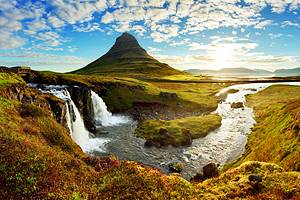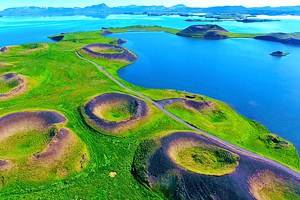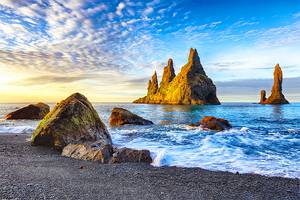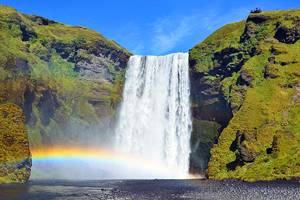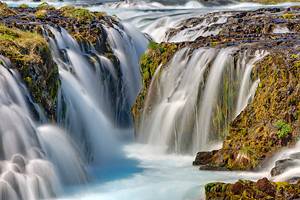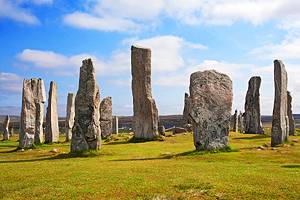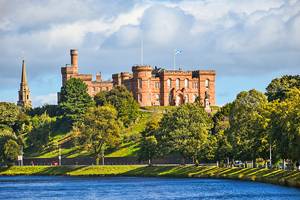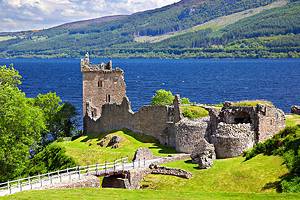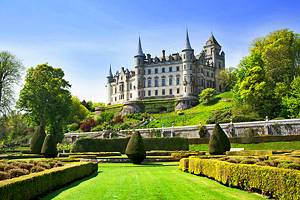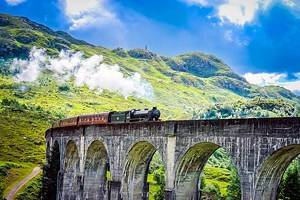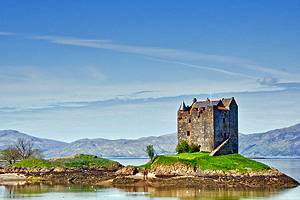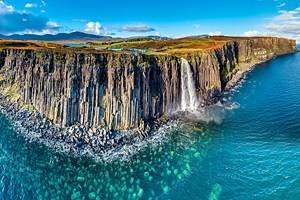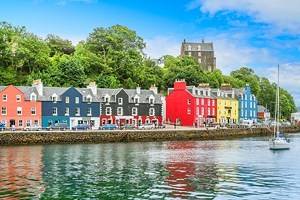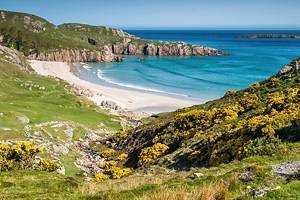Tourist Attractions in Iceland
Author Anietra Hamper has traveled throughout Iceland tackling outdoor adventures, from four-wheel driving over lava fields and fishing to taking in the waterfalls, hiking trails, and scenic drives.
Iceland, the island of fire and ice, has become one of the world's top travel destinations, not only for thrill-seeking adventurers but also for nature lovers looking for something different.
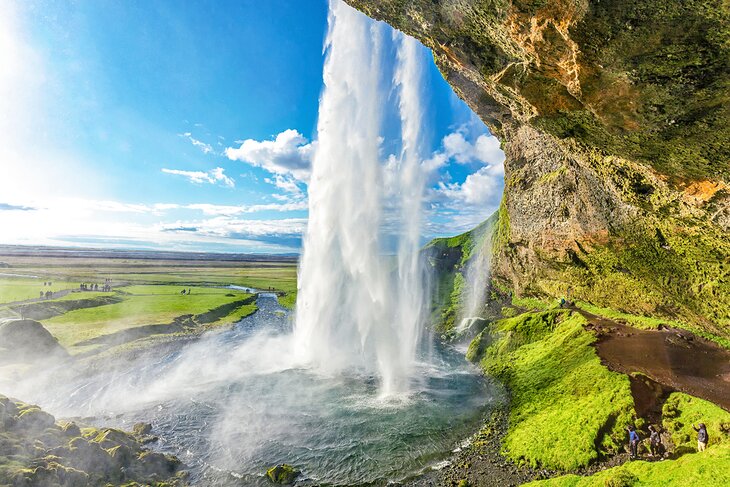
Here, you'll discover active volcanoes, geysers, hot springs, glaciers, ice fields, and fjords, for this sparsely populated country, resting at the edge of the Arctic Circle, sits atop one of the world's most volcanically active areas.
One way to explore Iceland is on your own with a rental car, from several days to a week, including a trip along the Ring Road that runs in a complete circle around the country.
Another way to plot your adventure in Iceland is with tours that can take you to the best options to see the northern lights; ATV trekking; and on day trips from Reykjavik to see some of Iceland's most stunning natural beauty, like the Blue Lagoon and waterfalls.
Find out more about the best places to visit with our list of the top attractions and things to do in Iceland.
- Explore Reykjavik by Foot
- Ride to the Top of Hallgrímskirkja
- Soak in the Blue Lagoon, Grindavík
- Gullfoss Waterfall
- Spot Whales out of Reykjavik
- Watch Spectacular Geysers
- Take in the Northern Lights, Aurora Borealis
- Hike in Landmannalaugar Nature Reserve
- Maelifell Volcano & Myrdalsjökull Glacier Park
- Attend a Concert at Harpa
- Explore the Skaftafell Ice Cave, Vatnajökull National Park
- Visit an Active Volcano at Askja Caldera
- Feel the Spray of Dettifoss Waterfall
- Kirkjufell Mountain, Grundarfjördur
- Hiking at Mount Esja
- Walk the Town of Akureyri
- Bird-Watching at Lake Myvatn & Nature Reserve
- The Pearl Observatory (Perlan)
- Rev up Adventure with an ATV Trek
- Float along a Glacial Lagoon
- Reynisfjara Black Sand Beach
- Tour the Raufarhólshellir Lava Tunnel
- Visit Iceland's Quirky Museums
- Best Time to Visit Iceland
Explore Reykjavik by Foot

The best way to start your trip to Iceland is by sightseeing in the capital city of Reykjavik. This is a walkable city with many museums, restaurants, attractions, public art, and entertainment.
Take a stroll to see some of the iconic locations in the city, like Hallgrimskirkja church and the Sun Voyager sculpture, or relax in one of Reykjavik's 17 thermal pools. You will enjoy walking up and down the city streets and perhaps stop into one of the many artsy and boutique shops to buy a wool sweater or lava pottery.
You can also book a Reykjavik Food Walk Tour and nibble your way through Reykjavik's food scene enjoying local cheeses, or try an authentic Icelandic hot dog.
Some of the best resorts in Iceland are in Reykjavik, so you can base yourself in the city and take day trips. An extremely popular way to visit nearby areas is on a South Coast Full Day Tour by Minibus from Reykjavik.
Ride to the Top of Hallgrímskirkja

A Reykjavik modernist icon, this visually striking church is one of the city's top attractions, and when you see it, you'll understand why. Hallgrimskirkja is the tallest and most recognizable building in the country.
The Black Falls (a basalt rock formation), which is one of Iceland's natural wonders, inspired the architectural design. A climb to the top of the 73-meter-high tower is particularly rewarding. Here, you'll be treated to spectacular views across the city and surrounding landscape.
At the front of the church is a statue of Icelander Leifur Eiriksson ("Leif the Lucky"), the first European to discover America around 1,000 CE. It seems he beat Christopher Columbus by around 500 years or so. For a small fee, you can take the elevator to the top and get the best panoramic view of Reykjavik.
Address: Hallgrímstorg 1 101, Reykjavik
Soak in the Blue Lagoon, Grindavík
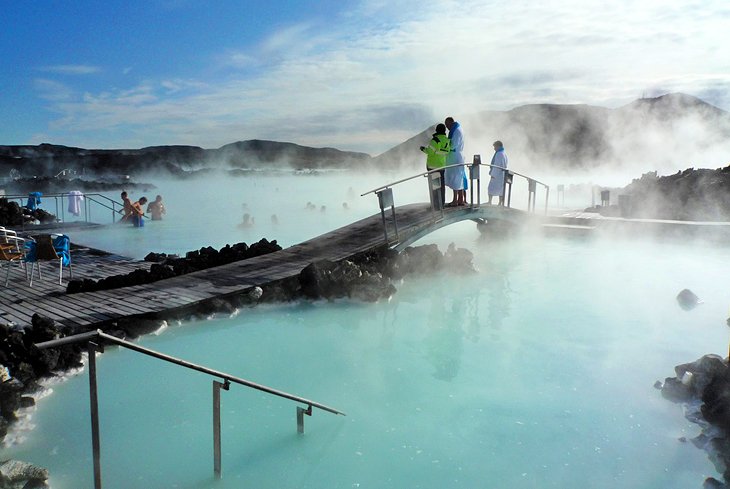
Just 40 minutes' drive from Reykjavík, the Blue Lagoon, the most iconic of geothermal spas, is a must-see tourist attraction. Here, you'll find natural bathing in pale blue water in the shadow of a power station.
An entire Blue Lagoon industry has grown around this attraction since it first became a hit with locals in 1976. The water from the underground hot springs reaches 37-39 degrees Celsius and is said to be highly beneficial for both health and skin.
If the die-hard Icelanders are anything to go by, don't knock the theory. Aside from bathing in a unique setting, there's a shop selling skincare products, a range of spa treatments, and places to eat and drink. Don't visit Iceland without coming here.
Rub on a mask of natural mud in minerals from one of the tubs located on the edges of the lagoon. For the ultimate relaxing visit, you can stay at one of the two hotels at the Blue Lagoon and add on a day at the Retreat Spa.
It is easy to book a bus trip to the Blue Lagoon from Reykjavik, but if you want to add an extra element of Iceland adventure, you can book a day trip on an ATV that will have you drive there over lava rock paths and take you back by coach to your hotel.
Address: Norðurljósavegur 9, 240 Grindavík
Gullfoss Waterfall
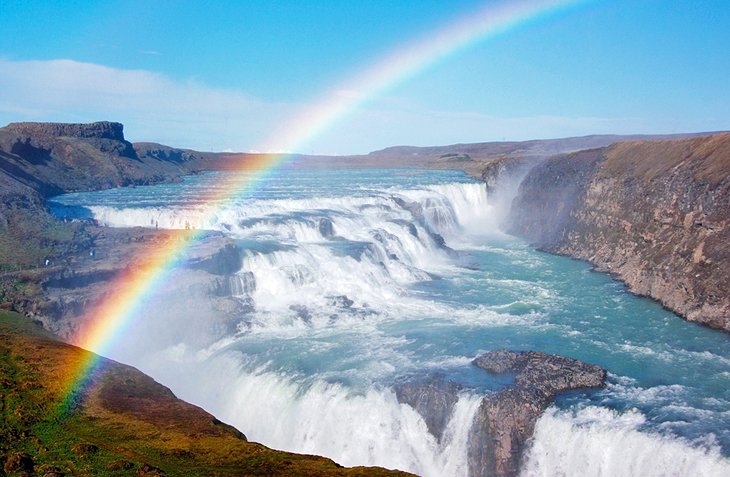
Magnificent Gullfoss Waterfall lies around 90 minutes west of Reykjavik and is one of the best waterfalls in Iceland. The river Hvítá plummets into a canyon, which forms three-step terraces, creating a powerful torrent. Gullfoss encompasses two cascades; the upper one drops 11 meters, while the lower one cascades about 21 meters.
Torrents of water flow over Gullfoss at an average rate of 109 cubic meters per second, although heavy floods have recorded an astonishing rate of nearly twenty times that. A word of warning: there are no rails or barriers, just a spine-tingling spectacle to enjoy amid surroundings as nature intended.
Spot Whales out of Reykjavik
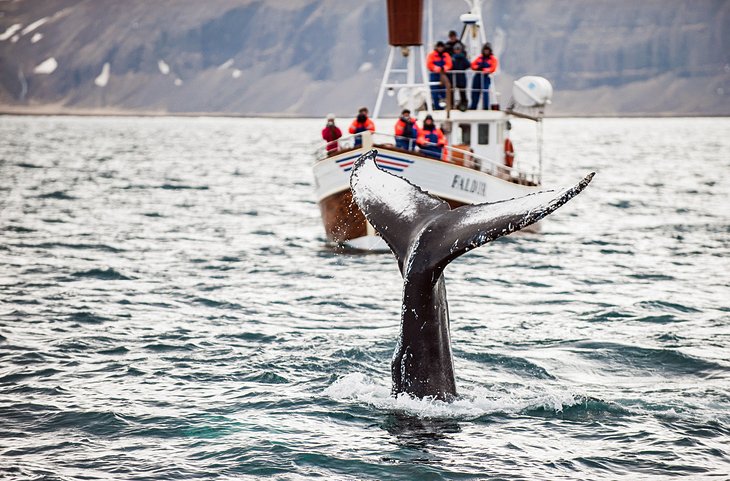
No matter what time of year you plan to travel to Iceland, whale watching happens year-round, although summer is the most popular time to see these gentle giants. During the warmer months, trips run day and night, including whale watching in the midnight sun.
Tour operators say there's an 80-95 percent chance of seeing these magnificent creatures, depending on the time of year. Best of all, surfacing often happens right near the boats, so you may well enjoy a ringside seat for one of nature's most awe-inspiring spectacles.
Other ocean-going tours are also available, such as bird-watching and island visits. Tours are convenient since there are several types available, and they depart from Reykjavik's Old Harbor. Stop for a dinner of fresh cod after you return in one of the many small, rustic restaurants located in the harbor area.
Address: Ægisgardur 5, Reykjavik's Old Harbor
Watch Spectacular Geysers
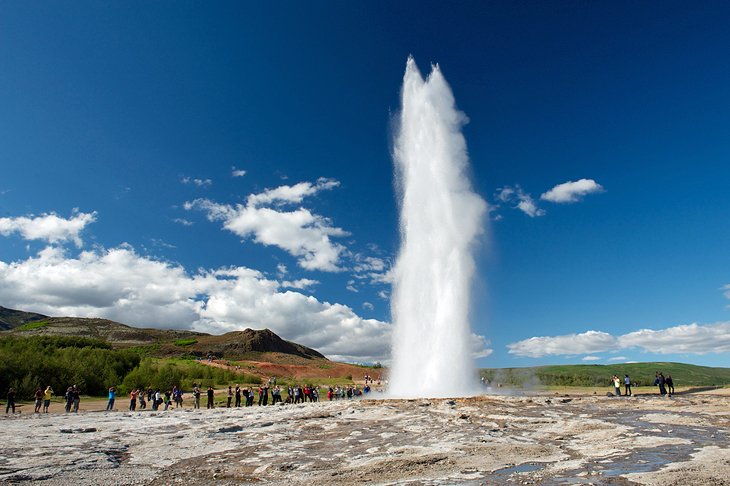
An easy 50-minute drive from Reykjavik, Strokkur Geysir (after which all geysers are named) is the most popular fountain geyser in the country and is famed throughout the world. This highly active hot spring area lies in the southwest of Iceland beside the Hvítá River and is a favorite stop along what's known as the Golden Circle.
Boiling mud pits and around 100 other smaller exploding geysers are waiting to be explored here. Every few minutes, Strokkur shoots water 30 meters into the air. Visit the Geysir Center for exhibits and informative presentations year-round.
A memorable experience is digging up Geysir or "hot spring" bread, rye bread that has been baking underground for 24 hours. Visitors can also help a chef boil eggs in a hot spring to accompany the bread. One popular day tour to the area is the Golden Circle Classic Day Trip from Reykjavik, which has several stops and can ensure you get the iconic geyser photo from your trip.
Take in the Northern Lights, Aurora Borealis

The northern lights, or Aurora Borealis, are among the most popular tourist attractions in Iceland. This is one of the best places in the world to see the northern lights.
Auroras are linked to solar wind, a flow of ions radiating from the sun. These particles become ensnared in the earth's magnetic field and collide with atmospheric molecules, causing bursts of energy, which appear as large circles around the poles. This spectacular natural light show is best admired in remote places and is particularly impressive at times of increased solar activity.
Since the appearance of the northern lights is unpredictable, most hotels and lodging operators can provide you with nightly predictions before you go to bed and add you to an overnight call list.
They will call your room if the lights appear, as they may only be visible for a short window of time. For one of the most optimal opportunities to experience the northern lights, you can take a tour like the Northern Lights Night Tour from Reykjavik, which takes you to the remote countryside for the best chance to see this natural wonder.
Hike in Landmannalaugar Nature Reserve
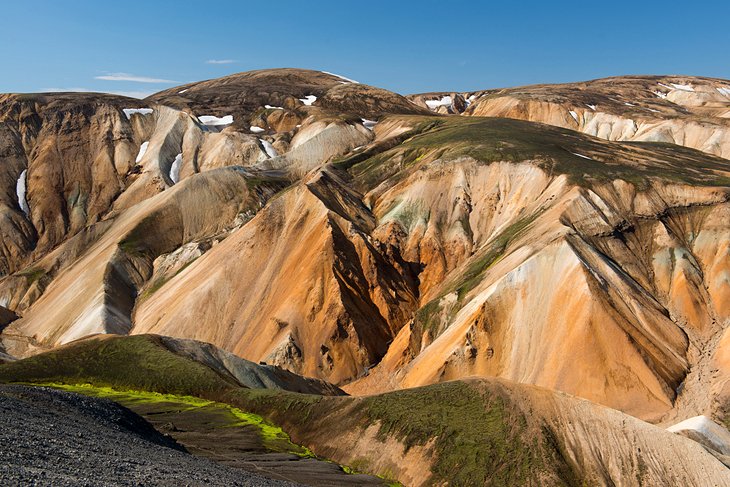
In the south of Iceland, 180 kilometers from Reykjavik, is Landmannalaugar National Park, one of Iceland's most popular tourist destinations. The main features of this mystical landscape are the multi-hued rhyolite mountains, Hekla volcano, and extensive lava fields.
Hiking and horse riding are popular things to do here, and hikes range from a couple of hours to several days. You can visit from June to late September, after which the road is closed. A mountain lodge (Landmannalaugar Hut) with basic facilities accommodates 75 people. Expect raw nature, rugged scenery, and utterly spectacular views.
Maelifell Volcano & Myrdalsjökull Glacier Park
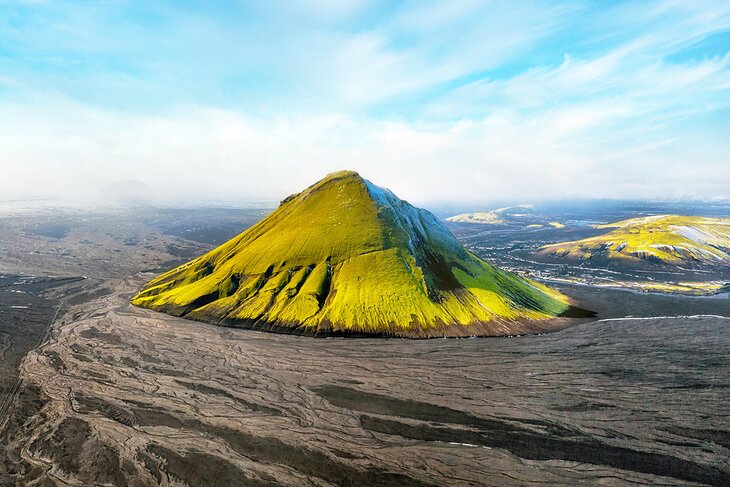
South of Landmannalaugar lies Myrdalsjökull Glacier Park, which for safety reasons can only be visited during summer. Large amounts of rain soak the area, particularly in winter, when roads can be severely damaged. Maelifell volcano is the undisputed jewel-in-the-crown of this wild, rugged glacial landscape.
The perfect cone shape gives Maelifell the look of a classic volcano, however during the warm season, a lavish green covering of moss gives it a surreal, otherworldly appearance. The park is full of volcanoes, hot springs, and other remarkable sites. To the west of Myrdalsjökull is a smaller glacier, Eyjafjallajökull (Island Mountain Glacier). A popular and thrilling way to explore is by snowmobile.
Attend a Concert at Harpa
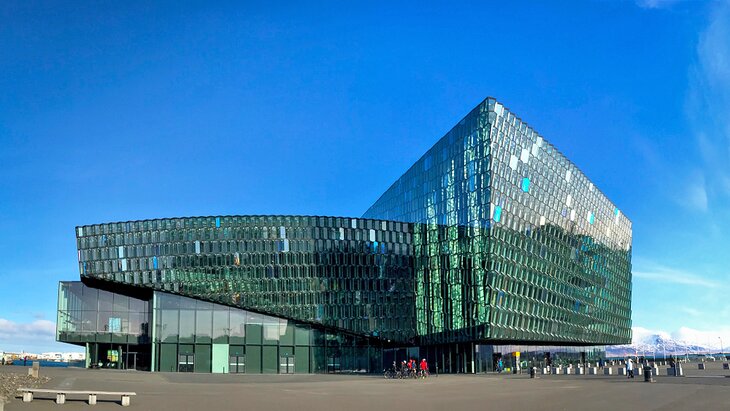
As you plan your time in Iceland, set aside an evening for a concert at the magnificent Harpa, Reykjavik's premier concert hall. If time or performance schedules do not fit your schedule, plan to at least stop by to admire the award-winning architecture of the building. Nighttime is one of the best times to see the array of colorful lights emanating from this honeycomb-shaped structure.
Harpa is a treasured landmark in Iceland, attracting international performances ranging from violinists and classical music to performing arts.
This venue makes for a great night out in the heart of the city. Enjoy dinner at one of Harpa's two restaurants and go for a stroll outside along the waterfront after the performance. The gift shop is a great place to pick up unique souvenirs, many made by local artists.
Address: Austurbakki 2, 101 Reykjavik
Explore the Skaftafell Ice Cave, Vatnajökull National Park
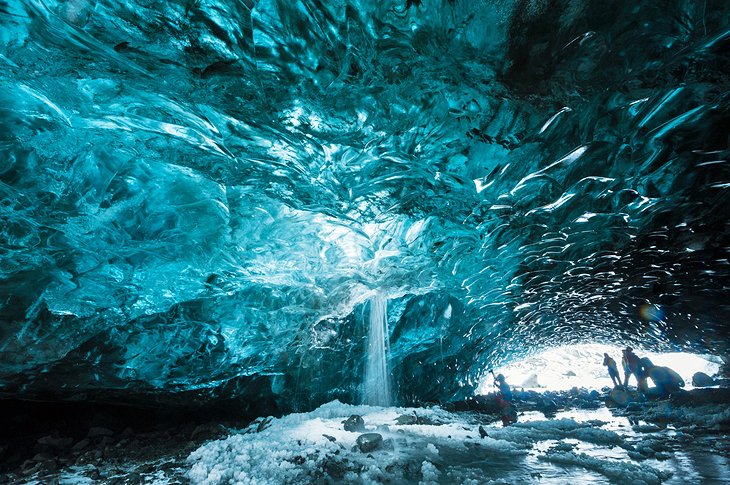
In the south of the country, Vatnajökull National Park is a land of glaciers and magnificent ice caves that attracts adventurers from across the globe. This vast national park (one of three in Iceland) is divided into four sections and consists of Vatnajökull glacier and its surroundings.
You'll find a number of visitor centers; those in Skaftafell Ice Cave and Höfn are open year-round, while Skriðuklaustur and Jökulsárgljúfur are closed in winter. The best time to visit Skaftafell Ice Cave is during winter after heavy rain has washed the top layer of the glacier away.
If seen at the right time, the cave is bathed in spectacular blue light. Group visits to all areas can be arranged off-season. If you are in good shape, you might consider doing a glacial trek with an experienced guide. The treks get you on the ice for an unforgettable experience to see glacial cracks and caves and even drink fresh water from small pools on the surface.
Visit an Active Volcano at Askja Caldera
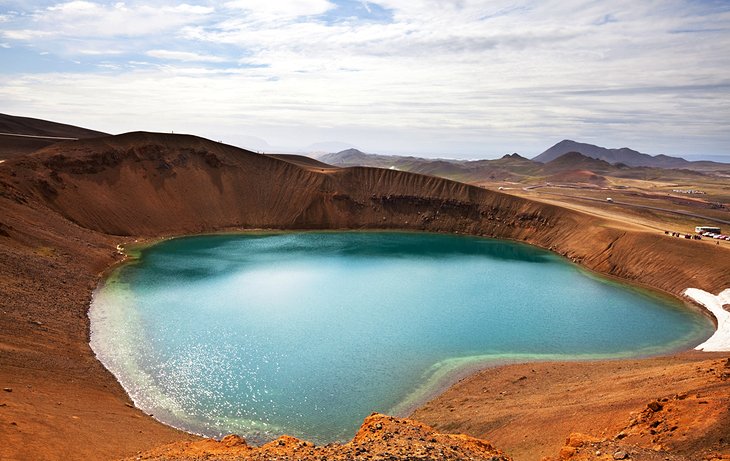
In the northern region of Vatnajökull National Park, the Askja caldera and the geothermal pool in the Dyngjufjöll Mountains are not for the faint-hearted. However, if you'd like to say you've taken a dip in a live volcano, then this is for you.
Askja is an impressive 50 square kilometers in size. The surrounding mountain range was formed during volcanic activity, and Askja was partly created by an eruption of burning ash that collapsed the roof of the central volcano's magma chamber.
The water in Viti, the geothermal pool and volcanic crater, is generally around 30 degrees Celsius. A word of warning, the banks can be very slippery, particularly in wet weather.
Feel the Spray of Dettifoss Waterfall
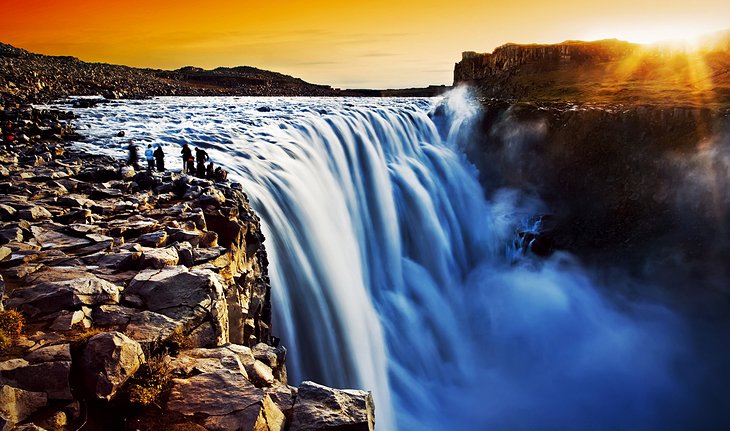
Dettifoss, in the north of Vatnajökull National Park, truly is a breathtaking example of the raw power of nature. Plunging 45 meters and with a width of 100 meters, it's said to be the most powerful waterfall in Europe.
Generally, it's best to approach on the east side of the River Jökulsa, where the road is better. Along easy paths from Dettifoss, Selfoss is a smaller waterfall around one kilometer upstream with a drop of around 10 meters. Below Dettifoss, the Hafragilsfoss waterfall tumbles 27 meters into a steep canyon. It's more advisable to drive than walk to Hafragilsfoss.
Kirkjufell Mountain, Grundarfjördur
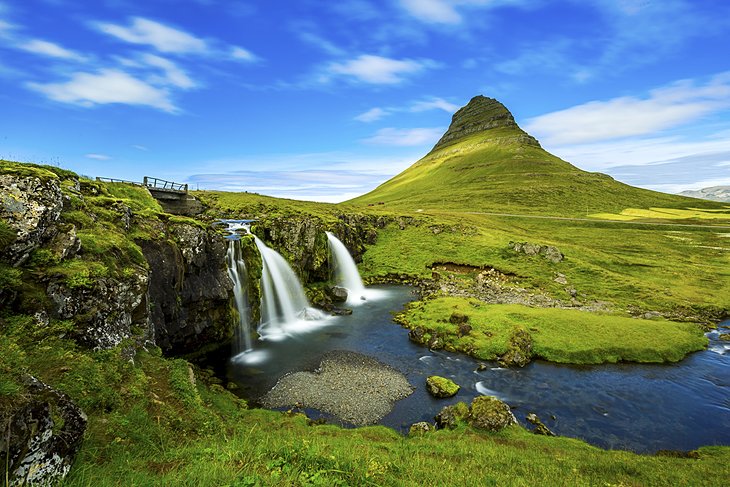
Around 2.5 hours' drive northwest of Reykjavik is the small town of Grundarfjördur, a charming fishing village centrally located on the north coast of the Snaefellsnes peninsula. The town lies in a picturesque fjord, surrounded by mountains, with Mt. Kirkjufell looming as a striking landmark.
Dotted about the surroundings, you'll discover small streams and waterfalls. During winter, Kirkjufell is a great place to watch the awe-inspiring northern lights. Eyrbyggja Heritage Centre holds exhibitions on Grundarfjördur's seafaring history and is the information center for the whole peninsula.
Hiking at Mount Esja

A 30-minute easterly drive from Reykjavik brings you to Mount Esja in Kjalarnes. The mountain is 914 meters high and very popular with hikers. Even for the inexperienced climber, it's a relatively easy hike. There are terrific views of Reykjavik and the surrounding landscape and ocean.
You can take several routes to the summit depending on your energy levels and how much time you have. You can get to the main starting point at Mount Esja by a 10-minute bus ride on public transportation that leaves out of the Hlemmur main station towards Artun. Check bus schedules and times before your visit.
Walk the Town of Akureyri

In the north of the country, Akureyri lies amid mountains on the longest fjord in Iceland about 40 kilometers south of the Arctic Circle. With a population of around 18,000, Akureyri's landscape and culture make it one of the best cities in Iceland. Summer days occasionally reach 25 degrees Celsius, and although winters bring heavy snowfall and cold weather, calm and still weather generally prevails.
Despite the town's isolation, cultural life and entertainment flourish here, and a wide range of shops offer brand-name products. The skiing area is the best in the country. Points of interest include the Akureyri Museum and the impressive Aviation Museum at Akureyri Airport.
Bird-Watching at Lake Myvatn & Nature Reserve
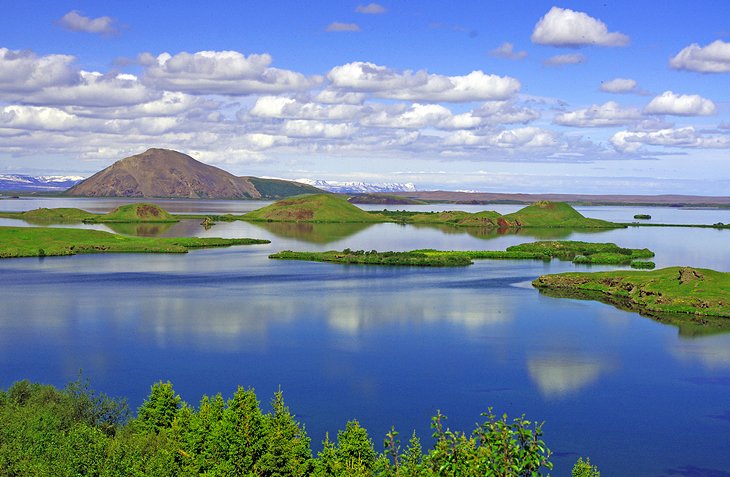
A little over an hour's easterly drive from Akureyri is Myvatn in northern Iceland. It is a lake district famous for its wealth of birdlife, rich fauna, and large shallow body of water. It's estimated that the area was formed around 2,500 years ago by a gigantic lava eruption.
Today, the surroundings are volcanically active, with an eruption occurring as recently as the mid-1980s. Bubbling clay pits, sulphuric fumes, and lava formations all form part of this unique landscape, which is still in flux.
One of the most interesting scenic features of Myvatn is the rootless vents formed by the volcanic eruption. While the landforms resemble craters, they did not have a lava flow, but the volcanic activity still resulted in their creation, adding to a stunning and unique appearance around the lake.
The name Myvatn literally means "midge-water," a reference to the prolific midges here, especially during summer, so be sure to pack some insect repellent. The area is also a bird-watcher's paradise.
The Pearl Observatory (Perlan)
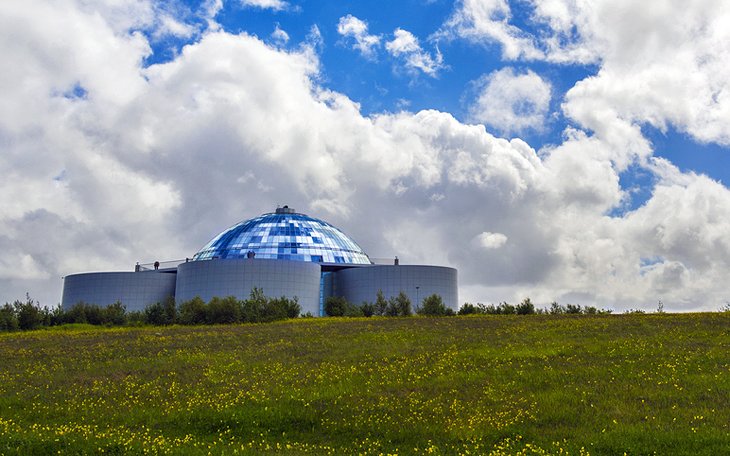
Originally the site of the city's gigantic thermal water tanks, "Perlan," as it's known locally, is one of Reykjavik's landmark buildings. It occupies an enviable location on Öskjuhlíð hill, where there are in excess of 176,000 trees.
The hill is particularly pleasant, with bicycle trails and footpaths zigzagging up and down. The observatory affords stunning views over the city. Also on-site is a revolving restaurant, as well as gourmet and souvenir shops.
In addition, Perlan regularly hosts concerts and exhibitions in the Winter Garden. The observation deck is a real treat. The new planetarium is spectacular with a virtual trip of Iceland featuring the country's natural elements.
Address: Varmahlíð 1, 105 Reykjavík
Rev up Adventure with an ATV Trek
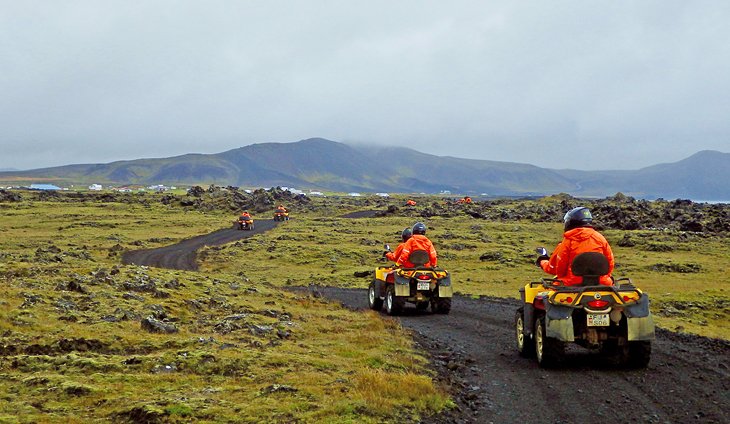
A popular thing to do and one of the most adventurous ways to experience Iceland is on the back of an ATV, trekking across rugged lava fields, riding up dormant volcanos, and passing pastures with roaming wild Icelandic ponies.
These are views of Iceland that you will never forget and one of the best ways to get up close to the country's most scenic natural environment. Tours like the two-Hour ATV Quad Tour from Reykjavik lets you experience ATV off-road adventure without a huge time commitment. Many tours depart from Reykjavik but they are available in most regions of the country.
Float along a Glacial Lagoon
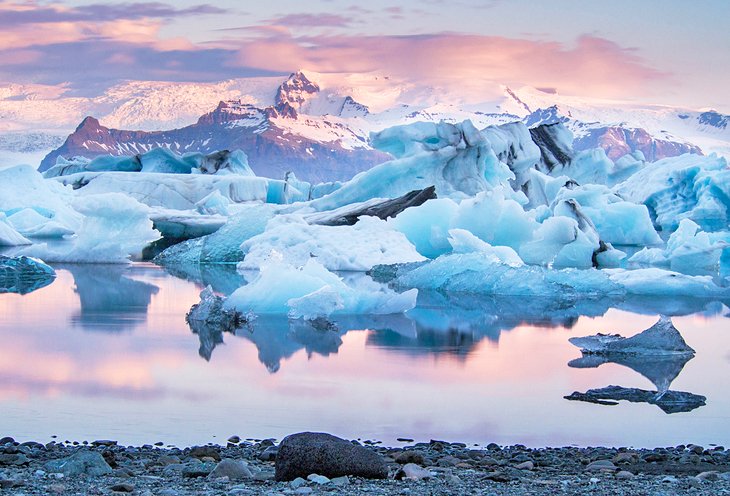
While Iceland is full of natural wonders, one of the most spectacular is the Jökulsárlón Glacier Lagoon. You will ride in a boat through large chunks of ice that have separated from the glacier.
The floating ice in the lagoon ranges from the size of small pebbles to the size of cars, but since you are floating in the lagoon with them, they are close enough to touch. Witness the blue hue of glacial cave formations and birds flying above in this natural environment.
The South Coast and Jökulsárlón Glacier Lagoon Day Tour from Reykjavik is a popular tour for visitors who want to set up a home base for their visit to Reykjavik and do a day trip to this top attraction. The tour also includes visits to two beautiful waterfalls and spectacular views of mountains and glacial rivers along the south coast.
Reynisfjara Black Sand Beach
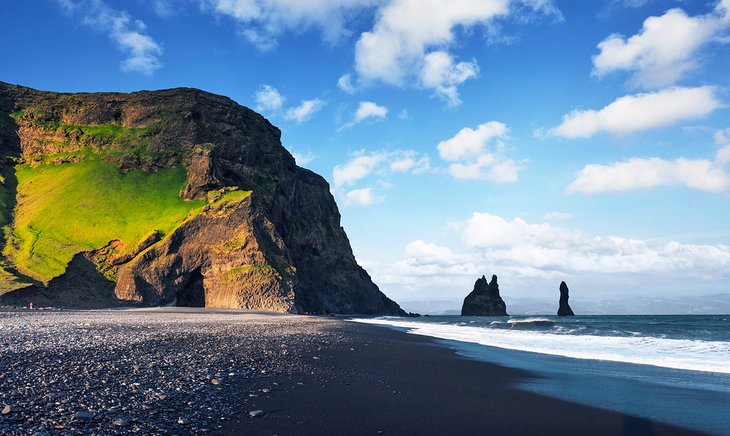
While Iceland has some stunning beaches, the Reynisfjara black-sand beach on the country's southern coast has an other-worldly appearance. This unique beach is known for its black sand and rocky sea stacks that protrude from the oftentimes ferocious waves coming in from the Atlantic Ocean.
The eerie yet stunning landscape of natural beauty at Reynisfjara beach is one of the reasons it was selected as a filming location for films like Star Wars. The lighting at this beach adds to its contrasting allure, which is why it is a must-visit for anyone who enjoys photography.
As with many natural locations in Iceland, Reynisfjara black-sand beach has dark folklore associated with it. Iceland legend says that the rocky basalt sea stacks were once trolls pulling seafaring ships to shore in the night, and they turned to stone during sunrise.
You are not likely to see any trolls during your visit, but you might see some of the thousands of seabirds, like puffins, guillemots, and fulmars, that nest in the columns.
The 2.5-hour drive to the beach is easy from Reykjavik, or you can take a guided trip along the southern coast that includes this as a stop if you want to spend more time at some of the other features on that side of the island.
Read More: Black Sand Beaches in the World
Tour the Raufarhólshellir Lava Tunnel

The land of fire and ice has so many intriguing natural elements that visiting is an exciting science lesson into how volcanos work. One way to find out is by visiting the Raufarhólshellir lava tunnel in southwest Iceland.
At 4,461 feet, it is one of the longest lava tubes in the country. You can take a guided tour through the cave to get up close to the stunning lava rock formations and colorful walls that have formed below the earth.
A tour through the tunnel will walk you through the path where lava flowed during a volcanic eruption of the Bláfjöll Mountain Range more than 5,000 years ago. These tunnels were formed as flowing magma hardened and thickened, creating a crust roof resulting in a lava tube.
Outside the lava tube, you will see stunning green moss covering lava rock and craters formed from the eruption. It is only about a half hour from Reykjavik, and you can visit year-round. If you visit in the winter, plan on wearing extra layers and sturdy boots for icy and wet conditions.
Visit Iceland's Quirky Museums

Iceland has an intriguing history of Vikings that settled on the island and folklore involving trolls and other creatures that still influence the culture today. One of the most interesting ways to learn about the varied tentacles of Icelandic culture is by visiting some of its museums. Some of them are seemingly mainstream, while others, sometimes found off the beaten path, explore some rather unusual finds.
In Reykjavik, the National Museum of Iceland is a good place to visit to explore Icelandic history and settlement. The Saga Museum also gives insight into the Viking heritage, with life-sized replicas of early settlers, offering a nice history lesson before you venture into some of the other types of museums.
Start your quirky museum visit with The Punk Museum on the back street of Reykjavik, which delves into Iceland's punk music scene that emerged in the 1970s. The Árbær Open Air Museum (within the Reykjavik City Museum) is another experience worth trying as you see more than 20 buildings that form a small early settlement village.
Not far from Reykjavik in Njarðvík is the Viking World Museum, which has an exact replica of a Viking ship that was discovered in Norway in the late 1800s and exhibitions detailing the Norse settlement.
One of the more unique museums in Iceland is the Sigurgeir's Bird Museum at Mývatn. The tiny museum features a collection of more than 300 preserved bird specimens representing over 180 species and an extensive collection of eggs.
The Library of Water in Stykkishólmur will give you insight into Iceland's natural environment, with dozens of columns holding water from ice caps. The Nonsense Museum in the Westfjords is a quirky stop to enjoy a large collection of random items, from sugar cubes to police hats that came from forces around the world.
For those who are interested in a deep dive into the history of Iceland's folklore, you should visit The Museum of Icelandic Witchcraft and Sorcery in the Westfjords in Hólmavík village. This museum gives insight into some of the tales and history on which Icelandic beliefs are based. This can be a tough visit for some, and parents should give it a preview before taking their children inside.
Best Time to Visit Iceland
When it comes to Iceland, the scenery is naturally stunning year-round, but certain times of the year are better than others to catch some of its most sought-after attributes.
For most visitors, the best time to visit Iceland is in the summer. But, the best time can also depend on what you want to experience. Do you want to catch a glimpse of the northern lights, visit when there is the most hours of daylight, or navigate the Ring Road with no snow? Or, do you want to travel during the low season to get the best rates on hotels and airfare? All of these factors matter when determining the best time to go to Iceland for your specific travel priorities.
Each season in Iceland comes with unique opportunities for exploration and the natural experiences that the island is famous for, like the midnight sun, aurora borealis, and hot springs.
Summer: Summer is hands down one of the best times to go to Iceland. It is the season with the best weather conditions, comfortable temperatures, the best opportunities for sightseeing, and when the roads and hiking trails are open and dry.
You get a front-row seat to the midnight sun. From May through August there is complete sunlight at midnight. While 24 hours of daylight makes it tough to sleep during your trip, it gives you more time to experience all that there is to see and do in Iceland. Summer is a great time to see minke whales out of Reykjavik.
Fall: The fall season is a lovely time to visit Iceland, when temperatures are slightly cooler, the summer tourists are gone, and the weather conditions are still favorable to do things like trekking on a glacier and riding an ATV over lava fields.
Fall colors on the trees are pretty, especially if you are horseback riding or hiking on one of the mountain trails. As fall dips into November, your chances of seeing the northern lights increase, and roads may start to close due to weather conditions. It is also a nice time to visit the Blue Lagoon when there are not so many tourists.
Winter: Winter days in Iceland can have almost 19 hours of darkness. It has the most inclement weather, but the top reason for visiting in the winter months is the chance to see the elusive northern lights. Prices will be cheaper for accommodations, and you will have plenty of availability on tours since it is the off-season.
Winter is a great time to take advantage of the snowfall in Iceland, with excursions like exploring ice caves and snowmobiling. It can be a fun time to visit the Blue Lagoon and the local hot springs where you can warm up – that is, until you get out.
Spring: Early spring in Iceland may still have snow-covered roads, but the days are starting to get longer. You also still have a chance to catch the northern lights during your visit. This shoulder season may limit some winter activities as they come to an end, and some summer excursions may not be available yet.
Spring is a great time to go whale watching, with many kinds of tours available out of Reykjavik. Spring is when you can catch a glimpse of another of Iceland's famous animal residents, the puffin, the unusual-looking bird that is more active in the spring.


